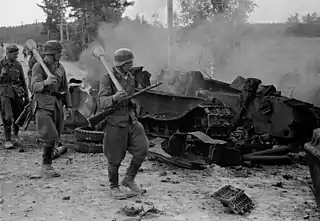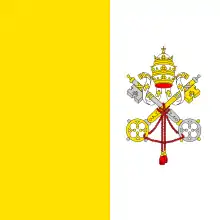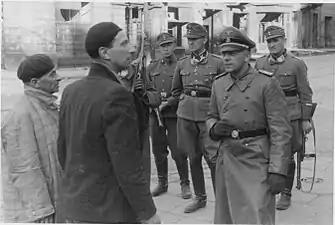Suomi KP/-31
The Suomi KP/-31 (Suomi-konepistooli or "Finland-submachine gun", literally: "Finland Machine-pistol") is a submachine gun (SMG) of Finnish design that was mainly used during World War II. It is a descendant of the M-22 prototype and the KP/-26 production model, which was revealed to the public in 1925. The Suomi-konepistooli KP/-31 is often abbreviated to Suomi KP.
| Suomi KP/-31 | |
|---|---|
.jpg.webp) Suomi KP/-31 | |
| Type | Submachine gun |
| Place of origin | Finland |
| Service history | |
| In service | 1931–1998 Finland (in active service 1980s) |
| Used by | See Users |
| Wars | Chaco War[1] Spanish Civil War[1] World War II (Winter War, Continuation War, and Lapland War)[2] 1948 Arab–Israeli War[3] Korean War |
| Production history | |
| Designer | Aimo Lahti |
| Designed | late 1920s |
| Manufacturer | Tikkakoski |
| Produced | 1931–1953 |
| No. built | Approx. 80,000 |
| Variants | Kpist m/37, Kpist m/37-39, Kpist m/37-39F, Lettet-Forsøgs, Madsen-Suomi, Hispano Suiza MP43/44 |
| Specifications | |
| Mass | 4.6 kg (10.14 lb) |
| Length | 870 mm (34.3 in) 925 mm (36.4 in) (SJR) 740 mm (29.1 in) (bunker version) |
| Barrel length | 314 mm (12.4 in) |
| Cartridge | 9×19mm Parabellum |
| Action | Straight Blowback |
| Rate of fire | 750–900 rounds/min |
| Muzzle velocity | 396 m/s (1,299 ft/s)[4] |
| Effective firing range | 200m[5] |
| Feed system | 20-, 36- or 50-round box, 40- or 71-round drum. Also modified German MP 38 & MP 40 32-round box magazine |
| Sights | Front blade, rear notch |
The Suomi KP/-31 is regarded by many[6] as one of the most successful submachine guns of World War II. It also had a profound effect on that conflict beyond Finland as the Soviet authorities, who had been dismissive of submachine guns, were persuaded of their deadly efficiency by the Finns after attacking them in 1939.[7] Its 71-round drum magazine was later copied and adopted by the Soviets for their PPD-40 and PPSh-41.[8] Though a relatively early design, the Suomi was a formidable weapon: highly controllable [9] and with accuracy superior to that of the mass-produced PPSh-41 [8] thanks in part to a noticeably longer barrel, with the same exceptionally high rate of fire and an equally large magazine capacity.[8] Its one major disadvantage was its high production cost, which led to the later introduction of the KP/-44, a close copy of the Soviet PPS-43 but accepting the existing magazines and drums for the KP/-31.
The M-22 and KP/-26 were made by Konepistooli Oy, founded by Master Armorer Aimo Lahti, Captain V. Korpela, Lieutenant Y. Koskinen and Lieutenant L. Boyer-Spoof. The Suomi KP/-31 was designed by Koskinen and Lahti.
History
The Suomi KP/-31 went into serial production in 1931 by Tikkakoski Oy and most of these weapons were bought by the Finnish Defence Forces. The Finnish Defence Forces were equipped with about 4000 Suomi KP/-31 submachine guns when the Winter War started. During the course of the war, the design was altered in February of 1942 with the addition of a muzzle brake, which increased the submachine gun's overall length by 55 mm and weight by half a pound. The revised version was designated KP/-31 SJR (suujarru, or "muzzle brake"). Aimo Lahti was displeased with this revision, believing that it decreased muzzle velocity and reduced the weapon's reliability, and even sought in vain to have the unknown designer of the brake court-martialed. Ultimately, roughly half of the KP/-31s in Finnish service were of the SJR version.
The KP/-31 was unusual in that it had a replaceable barrel secured with four lugs rather than threads. Soldiers were issued at least one spare barrel. In close combat the weapon would overheat in sustained automatic fire, requiring the barrel to be changed. This was effected using a mitten or piece of thick cloth to secure, rotate, and remove the barrel jacket. Then the user would use the point of a puukko knife or a cleaning rod to loosen and remove the hot barrel. It was easy to then slide in and lock a fresh new barrel, secure the jacket, and resume firing.
The Finnish military initially issued it with the 20-round staggered-column magazine and early 40-round sissilipas ("ranger magazine") drum. The magazine's capacity was found to be too small for sustained fire. Up to 5 additional rounds could be loaded into it, but it was found that this damaged or over-compressed the springs and caused it to fail. The drum was found to be hard to reload in action because the backplate had to be taken off and the bullets loaded inside tip-downwards. The drum also had an open "shot count window" in the bottom of the drum; the numbers 1 to 40 were stamped on the feed plate and lined up with the window to indicate the shots remaining. However, it naturally let in dirt and debris that led to jams. Aimo Lahti experimented with a 60-round Thompson-type spring-loaded clockwork drum to replace it, but it was never adopted.
They were later replaced during the Continuation War with the Swedish-designed 50-round "coffin" magazine and improved 71-round drum. The "coffin" magazine carried more ammunition than the box magazine and was lighter than the 40-round drum. However, it was complicated and prone to jamming or failure if it was damaged, reassembled incorrectly, or the springs gave out. It would also fail to fire or feed unless it was properly seated in the magazine well. The "coffin" magazine was withdrawn from service in 1943 in favor of the 71-round drum. The larger drum was a design by the weapon's less-well-known co-designer, Lieutenant Y. Koskinen, that was an improvement of the 40-round drum. It had a removable front-plate that was quicker to reassemble and was cocked by rotating the mainspring for up to four detents, allowing the drum to be partially reloaded. It was first released commercially in 1935 (eponymously named the M/Koskinen drum) and entered into Finnish service in January, 1936. In the 1950s the magazine wells on the KP/-31s were modified in order to use the Swedish Carl Gustav m/45b's 36-round double-column magazine.
Tactics
Initially the KP/-31 was issued as a substitute for a light machine gun, and proved inadequate in this role. Instead, soldiers learned by trial and error how to use submachine guns to the best effect. By the time of the Continuation War, Finnish doctrine had been altered to include both a KP/-31 and a light machine gun (usually a captured Degtyaryov DP) in every infantry squad. By 1943 this had been expanded to two KP/-31s per squad. KP/-31 production continued with the intention of adding a third submachine gun to each squad, but this plan was shelved in 1944 when the Continuation War ended.
Sales

Finland focused on sales to South America and the Baltic States. It was sold to both sides during the Spanish Civil War; about 300 were confiscated by France from interned Republican troops in 1939. Estonia, France, and Poland bought some before World War Two that were later captured. Germany and their Axis allies Bulgaria and Croatia bought some after the war began. The German Armeeoberkommando Norwegen and Finnish SS Troops were issued the KP/-31 from Finnish stores. A weld-on magazine adapter was created by the Germans to convert MP38/MP40 magazines to feed in the KP/-31 to simplify logistics.
The Suomi KP was also manufactured under license. It was made in Sweden as the Husquarna Kulsprutepistol Kpist M37 with a shorter 8.4-inch [213 mm] barrel. It was chambered for the weak 9mm Browning Long [9x20mmSR] cartridge, which required a rear-slanting magazine well. It used a 56-round four-column "coffin" magazine designed by Linde AB and manufactured by the Carl Gustav State Rifle Factory. They later adopted the redesigned Husquarna Kpist M37/39 chambered in 9mm Parabellum with a standard-length barrel [314mm] and 50-round "coffin" magazine. The Danish adopted it as the Madsen Maskinpistol M/41. It has distinctive protective metal “ears” on either side of the front post sight and used the 20-round magazine. The Swiss adopted it as the Hispano-Suiza Machinenpistole MP43 and issued it with the "coffin" magazine. The later MP43/44 had a fixed square notch rather than adjustable rear sights and the barrel jacket was modified to take a bayonet mount.
Design
The Suomi KP/-31 incorporated a few new design features. It had a quick-detachable barrel system and an arrangement whereby the spring was mounted inside the bolt in order to make the gun shorter.
The Carl Gustav 50-round quad-column "casket" box magazine was lighter and more reliable than the original Lahti 40-round "ranger" drum magazine. Similar applications were used on the Argentinian Hafdasa C-4 and Italian SITES Spectre M4 submachine guns. The Russian company PUFgun makes a 5.45x39mm 60-round AK-74-compatible all-polymer coffin magazine that was based on an abandoned Izhmash prototype.
The 71-round Lahti drum was copied by the Soviets in a scaled-down 7.62mm version for their PPSh-41.
Variants
A specialized bunker version was also produced in very small numbers (a total of 500 built) in 1941, the barrel shroud end of which was thinner and flattened to allow firing through the narrow ports of defensive bunkers.[10] This version had no shoulder stock and was equipped with a pistol grip. An even rarer version "900 kp 31 psv"[10] was produced for use as a secondary gun in the firing ports of Vickers Alt B Type E 6-Ton tanks, but only a few dozen were built before production was canceled due to the outbreak of the Winter War. Production never resumed, as captured Degtyaryov DP machine guns proved far superior in this role. Like the bunker version, the tank version had a pistol grip and no buttstock, and it could be quickly removed from the tank and fitted with a standard barrel shroud for infantry use if needed. The tank version remained in the Finnish Army's inventory through the 1980s, despite the tank it was designed for being retired in 1959.
Users
 Bolivia[11]
Bolivia[11] Bulgaria: 5,000 were bought from 1940–1942.[12]
Bulgaria: 5,000 were bought from 1940–1942.[12].svg.png.webp) NDH: 1,250 were bought from 1940-1942 of which 500 were delivered.[12]
NDH: 1,250 were bought from 1940-1942 of which 500 were delivered.[12] Denmark: 32 were bought from Finland, some Swedish m/37-39 were also purchased[12] and 1,400 copies, designated m/41, were manufactured in the kingdom during WWII until Germany disarmed all the Danish army in August 1943.[13]
Denmark: 32 were bought from Finland, some Swedish m/37-39 were also purchased[12] and 1,400 copies, designated m/41, were manufactured in the kingdom during WWII until Germany disarmed all the Danish army in August 1943.[13].svg.png.webp) Egypt: Used Swedish-made kpist m/37-39s.[12]
Egypt: Used Swedish-made kpist m/37-39s.[12] Estonia: 5 KP/-26 were purchased for evaluation.[14] 485 KP-31 were purchased in 1937.
Estonia: 5 KP/-26 were purchased for evaluation.[14] 485 KP-31 were purchased in 1937. Finland
Finland France: 150 KP/-31 seized from various sources were supplied to French troops during the Phoney War.[15]
France: 150 KP/-31 seized from various sources were supplied to French troops during the Phoney War.[15] Indonesia: Used Swedish-made kpist m/37-39s.[12]
Indonesia: Used Swedish-made kpist m/37-39s.[12] Israel[3]
Israel[3].svg.png.webp) Nazi Germany: 3,042 were ordered by Germany from Finland during WWII and likely issued to the Wehrmacht and SS. Also 120 Suomi KP's were presented to the German troops of AOK Norwegen in 1942 for use on the Finnish Front.[16] Most of these weapons left Finland with German troops in 1944 and were subsequently used in other theaters of the war.
Nazi Germany: 3,042 were ordered by Germany from Finland during WWII and likely issued to the Wehrmacht and SS. Also 120 Suomi KP's were presented to the German troops of AOK Norwegen in 1942 for use on the Finnish Front.[16] Most of these weapons left Finland with German troops in 1944 and were subsequently used in other theaters of the war. Norway: Swedish m/37-39 variant.[12] Norwegian police troops trained in Sweden used the Swedish m/37-39 variant. Used by the Norwegian armed forces after the war until the 1980s, primarily by the Navy, Air Defence and the Home Guard.
Norway: Swedish m/37-39 variant.[12] Norwegian police troops trained in Sweden used the Swedish m/37-39 variant. Used by the Norwegian armed forces after the war until the 1980s, primarily by the Navy, Air Defence and the Home Guard. North Korea
North Korea Paraguay[11]
Paraguay[11] Poland: Used by the Police until 1939[17]
Poland: Used by the Police until 1939[17] Slovakia: Used by Slovak forces on the eastern front of WW2.[18]
Slovakia: Used by Slovak forces on the eastern front of WW2.[18].svg.png.webp) Spain: Used by both sides[17][19]
Spain: Used by both sides[17][19].svg.png.webp) Spanish State
Spanish State Sweden: 35,000 made under license by Husqvarna Vapenfabriks AB just before and during World War II, some were also imported from Finland. Designated kpist m/37 (9mm Browning Long caliber) after the year of adaption. In 1939 Sweden decided to switch to 9 mm Parabellum and the new weapons were designated kpist m/37-39.[20]
Sweden: 35,000 made under license by Husqvarna Vapenfabriks AB just before and during World War II, some were also imported from Finland. Designated kpist m/37 (9mm Browning Long caliber) after the year of adaption. In 1939 Sweden decided to switch to 9 mm Parabellum and the new weapons were designated kpist m/37-39.[20] Switzerland: 100 KP/-41 delivered (of 5,000 ordered)[12] and designated MP 43. 22,500 produced under license by Hispano-Suiza as MP 43/44.[13]
Switzerland: 100 KP/-41 delivered (of 5,000 ordered)[12] and designated MP 43. 22,500 produced under license by Hispano-Suiza as MP 43/44.[13] Soviet Union: Used captured weapons.[16] A copy in 7.62×25mm Tokarev caliber was produced in Leningrad as Karelo-Finskii KF-42.[13]
Soviet Union: Used captured weapons.[16] A copy in 7.62×25mm Tokarev caliber was produced in Leningrad as Karelo-Finskii KF-42.[13] Vatican: Pontifical Swiss Guard used Hispano-Suiza version until the 1970s.[13]
Vatican: Pontifical Swiss Guard used Hispano-Suiza version until the 1970s.[13]
Gallery
 KP/-31 with World War II-era magazines and cleaning kit
KP/-31 with World War II-era magazines and cleaning kit Bunker model KP/-31
Bunker model KP/-31 KP/-31 with sectioned drum magazine
KP/-31 with sectioned drum magazine KP/-31 with drum magazine and ammunition package, below a sectioned example as well as a sectioned and normal drum magazine
KP/-31 with drum magazine and ammunition package, below a sectioned example as well as a sectioned and normal drum magazine KP/-31 drum magazines, a sectioned example on the left
KP/-31 drum magazines, a sectioned example on the left Swiss made Mp 43/44
Swiss made Mp 43/44 Internal drawing of the Suomi SMG from the original patent
Internal drawing of the Suomi SMG from the original patent A Finnish sub-machinegunner during the Battle of Vuosalmi in Karelian Isthmus
A Finnish sub-machinegunner during the Battle of Vuosalmi in Karelian Isthmus Early 7.65 mm Suomi KP/-26
Early 7.65 mm Suomi KP/-26 Stroop report during Warsaw Ghetto Uprising in May 1943. Germans 1st from right and 4th from right are armed with Suomi KP/-31 submachine guns.
Stroop report during Warsaw Ghetto Uprising in May 1943. Germans 1st from right and 4th from right are armed with Suomi KP/-31 submachine guns. USSR PPD-34-38
USSR PPD-34-38 USSR PPSh-41
USSR PPSh-41_model_1937-39_AM.067715_(right)_(cropped).jpg.webp) Swedish Kulsprutepistol m/37
Swedish Kulsprutepistol m/37
See also
References
- Guns of the Third Reich, p. 163
- Thompson, Leroy (23 Mar 2017). The Suomi Submachine Gun. Weapon 54. Osprey Publishing. ISBN 9781472819642.
- Thompson 2017, p. 6.
- Thompson 2017, p. 4.
- Thompson 2017, p. 5.
- "Gunwritersin Suomi-KP, osa 5". Guns.connect.fi. Retrieved 2011-12-06.
- "Suomi submachine gun (Finland)". Modern Firearms. Retrieved 12 February 2017.
- Combat Guns: An Illustrated Encyclopedia of 20th Century Firearms, Osprey, 1987 ISBN 9780600551782
- "Soviet Submachine Guns of World War II." Chris McNab, Osprey Publishing, Page 9.
- Kekkonen, P. "Suomi Submachine Gun, KP/-31, part 2/2". Gunwriters. Retrieved 12 February 2017.
- "Suomi m/31 - Finland's Excellent Submachine Gun." Forgotten Weapons. https://www.youtube.com/watch?v=CiTS3dcYicw&t=951s
- Kekkonen, P.T. (1999). "Mallit, variaatiot ja lisenssikopiot". Gunwriters (in Finnish). Retrieved 12 February 2017.
- Huon, Jean (September 2013). "The Chaco War". Small Arms Review. Vol. 17 no. 3.
- Thompson 2017, p. 69.
- Thompson 2017, p. 70.
- Thompson 2017, p. 10.
- Bellec, Olivier (June 2000). "L'équipement et l'armement des corps francs". Militaria Magazine (in French). No. 179. Histoire & Collections. pp. 39–44.
- Thompson 2017, p. 56.
- "Suomi m/1931". Encyclopédie des armes : Les forces armées du monde (in French). I. Atlas. 1986. p. 23.
- https://www.ww2-weapons.com/slovak-armed-forces/
- Thompson 2017, pp. 68-69.
- "kpistar i Sverige". Gotavapen.se. Retrieved 2011-12-06.
External links
| Wikimedia Commons has media related to Suomi M31. |
